Do you have a question about the Invacare Perfecto2 V IRC5PO2V and is the answer not in the manual?
Defines DANGER, WARNING, and CAUTION signal words used in the manual.
Warns against smoking and ignition sources due to oxygen enrichment.
Identifies key components visible on the front of the oxygen concentrator unit.
Lists and briefly describes available accessories for the unit.
Details electrical requirements, dimensions, weight, and environmental operating parameters.
Lists oxygen output concentration, pressure, flow range, and safety system features.
Outlines regulatory compliance and recommended tubing requirements for the device.
Explains the meaning of different indicator lights (LEDs) and their corresponding status.
Provides essential safety guidelines for operating the Perfecto2V concentrator.
Details risks associated with oxygen use and potential ignition sources.
Covers safe handling, placement, and avoiding obstructions for the unit.
Advises on exercising caution with portable communication equipment around the device.
Lists specific actions to reduce risks of electrical shock, fire, and personal injury.
Outlines steps to verify the proper function of the battery-free power loss alarm.
Describes the internal process of how the concentrator generates and delivers oxygen.
Explains the working principle of the SensO2 oxygen sensor.
Details how the ceramic zirconia sensor measures oxygen concentration.
Describes the sequence of operation for the SensO2 system upon unit startup.
Explains how the GREEN, YELLOW, and RED indicator lights function based on oxygen purity.
Illustrates the pneumatic connections and flow paths within the oxygen concentrator.
Provides solutions for common issues like normal operation indicators and power loss scenarios.
Addresses power loss issues and symptoms of high pressure within the system.
Details causes and solutions for low pressure conditions and defective components.
Guides users on issues when the unit is not operating or low oxygen concentration is detected.
Covers troubleshooting for low concentration and unstable or fluctuating oxygen flow.
Addresses overheating issues and problems related to oxygen purity indicators.
Solves issues with unit operating alarms and the low-flow alarm not activating.
Provides step-by-step instructions for removing and reattaching the unit's cabinet.
Details the procedure for cleaning the main cabinet air filter.
Explains how to check and replace the HEPA filter located at the oxygen outlet.
Provides instructions for replacing the HEPA filter for the compressor inlet.
Details the steps for replacing the exhaust muffler assembly.
Describes the process for cleaning the heat exchanger component.
A form to log maintenance dates, hours, and tasks performed on the concentrator.
Step-by-step guide for removing and installing the main compressor unit.
Instructions for replacing the capacitor associated with the compressor.
Details the contents of the rebuild kit and necessary tools for compressor overhaul.
Guides on how to detach the compressor head and its associated parts.
Describes the removal process for the fan, connecting rod, and piston cup components.
Details the procedure for removing intake and exhaust valve flappers.
Covers reassembly steps for valve plates, o-rings, and piston cups during compressor rebuild.
Continues compressor reassembly instructions for connecting rod, fan, valve plates, and head.
Lists the part numbers and quantities for the GSE 280D2 compressor rebuild kit.
Provides instructions for removing and installing the Pressure Equalization (P.E.) valve.
Step-by-step guide for removing and installing the sieve beds in the concentrator.
Instructions for removing and installing the spacers used with the sieve beds.
Details the procedure for replacing the one-way directional check valves.
Instructions for removing and installing the pressure regulator.
Explains how to adjust the output pressure of the regulator to the specified level.
Steps for removing and installing the heat exchanger assembly.
Provides instructions for removing and reinstalling the main control panel assembly.
Details the procedure for removing and installing the unit's cooling fan.
Step-by-step guide for removing and installing the Printed Circuit (P.C.) board.
Instructions for removing and installing the power transformer.
Details the procedure for replacing the power On/Off switch.
Instructions for removing and installing the flowmeter.
Details the procedure for replacing the unit’s hour meter.
Step-by-step guide for replacing the 4-way valve or manifold assembly.
Instructions for replacing pilot valve poppets and O-rings within the valve assembly.
Explains the function of the SensO2 oxygen purity indicator and its alarm conditions.
Guides the user through the automatic tuning process for the P.E. valve timing.
Provides further details and steps for completing the autotuning process.
Details the steps for manually adjusting the P.E. valve timing.
Outlines the procedure for testing the oxygen concentrator for leaks.
Explains how to test the 4-way valve and its acceptable leak specifications.
Details how to test the power loss and low pressure alarms.
Describes the procedures for testing the time-out and high pressure alarms.
Outlines the test procedure for the oxygen sensor alarm.
Explains the different SensO2 alarm thresholds and their corresponding indicator light signals.
Details the procedure for testing the P.E. valve coil for alarm conditions.
Provides a reference label for diagnostic alarm system codes and probable causes.
Describes a post-service check of sieve bed pressure.
Outlines the steps for performing pressure testing on the sieve beds.
Provides specific pressure readings and timing for sieve bed pressure tests.
Refers users to the owner's manual or Invacare for warranty details.
Defines DANGER, WARNING, and CAUTION signal words used in the manual.
Warns against smoking and ignition sources due to oxygen enrichment.
Identifies key components visible on the front of the oxygen concentrator unit.
Lists and briefly describes available accessories for the unit.
Details electrical requirements, dimensions, weight, and environmental operating parameters.
Lists oxygen output concentration, pressure, flow range, and safety system features.
Outlines regulatory compliance and recommended tubing requirements for the device.
Explains the meaning of different indicator lights (LEDs) and their corresponding status.
Provides essential safety guidelines for operating the Perfecto2V concentrator.
Details risks associated with oxygen use and potential ignition sources.
Covers safe handling, placement, and avoiding obstructions for the unit.
Advises on exercising caution with portable communication equipment around the device.
Lists specific actions to reduce risks of electrical shock, fire, and personal injury.
Outlines steps to verify the proper function of the battery-free power loss alarm.
Describes the internal process of how the concentrator generates and delivers oxygen.
Explains the working principle of the SensO2 oxygen sensor.
Details how the ceramic zirconia sensor measures oxygen concentration.
Describes the sequence of operation for the SensO2 system upon unit startup.
Explains how the GREEN, YELLOW, and RED indicator lights function based on oxygen purity.
Illustrates the pneumatic connections and flow paths within the oxygen concentrator.
Provides solutions for common issues like normal operation indicators and power loss scenarios.
Addresses power loss issues and symptoms of high pressure within the system.
Details causes and solutions for low pressure conditions and defective components.
Guides users on issues when the unit is not operating or low oxygen concentration is detected.
Covers troubleshooting for low concentration and unstable or fluctuating oxygen flow.
Addresses overheating issues and problems related to oxygen purity indicators.
Solves issues with unit operating alarms and the low-flow alarm not activating.
Provides step-by-step instructions for removing and reattaching the unit's cabinet.
Details the procedure for cleaning the main cabinet air filter.
Explains how to check and replace the HEPA filter located at the oxygen outlet.
Provides instructions for replacing the HEPA filter for the compressor inlet.
Details the steps for replacing the exhaust muffler assembly.
Describes the process for cleaning the heat exchanger component.
A form to log maintenance dates, hours, and tasks performed on the concentrator.
Step-by-step guide for removing and installing the main compressor unit.
Instructions for replacing the capacitor associated with the compressor.
Details the contents of the rebuild kit and necessary tools for compressor overhaul.
Guides on how to detach the compressor head and its associated parts.
Describes the removal process for the fan, connecting rod, and piston cup components.
Details the procedure for removing intake and exhaust valve flappers.
Covers reassembly steps for valve plates, o-rings, and piston cups during compressor rebuild.
Continues compressor reassembly instructions for connecting rod, fan, valve plates, and head.
Lists the part numbers and quantities for the GSE 280D2 compressor rebuild kit.
Provides instructions for removing and installing the Pressure Equalization (P.E.) valve.
Step-by-step guide for removing and installing the sieve beds in the concentrator.
Instructions for removing and installing the spacers used with the sieve beds.
Details the procedure for replacing the one-way directional check valves.
Instructions for removing and installing the pressure regulator.
Explains how to adjust the output pressure of the regulator to the specified level.
Steps for removing and installing the heat exchanger assembly.
Provides instructions for removing and reinstalling the main control panel assembly.
Details the procedure for removing and installing the unit's cooling fan.
Step-by-step guide for removing and installing the Printed Circuit (P.C.) board.
Instructions for removing and installing the power transformer.
Details the procedure for replacing the power On/Off switch.
Instructions for removing and installing the flowmeter.
Details the procedure for replacing the unit’s hour meter.
Step-by-step guide for replacing the 4-way valve or manifold assembly.
Instructions for replacing pilot valve poppets and O-rings within the valve assembly.
Explains the function of the SensO2 oxygen purity indicator and its alarm conditions.
Guides the user through the automatic tuning process for the P.E. valve timing.
Provides further details and steps for completing the autotuning process.
Details the steps for manually adjusting the P.E. valve timing.
Outlines the procedure for testing the oxygen concentrator for leaks.
Explains how to test the 4-way valve and its acceptable leak specifications.
Details how to test the power loss and low pressure alarms.
Describes the procedures for testing the time-out and high pressure alarms.
Outlines the test procedure for the oxygen sensor alarm.
Explains the different SensO2 alarm thresholds and their corresponding indicator light signals.
Details the procedure for testing the P.E. valve coil for alarm conditions.
Provides a reference label for diagnostic alarm system codes and probable causes.
Describes a post-service check of sieve bed pressure.
Outlines the steps for performing pressure testing on the sieve beds.
Provides specific pressure readings and timing for sieve bed pressure tests.
Refers users to the owner's manual or Invacare for warranty details.
| Brand | Invacare |
|---|---|
| Model | Perfecto2 V IRC5PO2V |
| Category | Medical Equipment |
| Language | English |
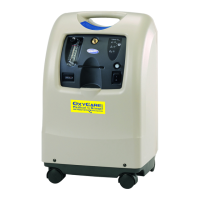



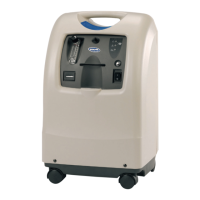
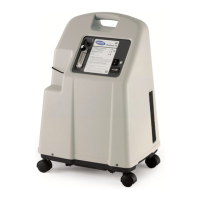
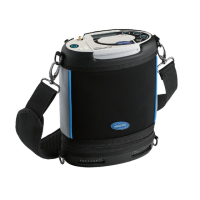
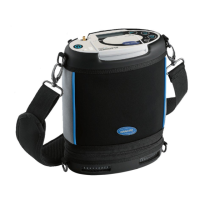
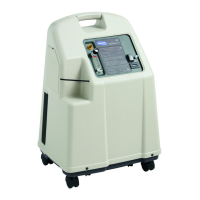
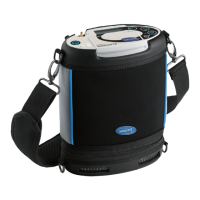

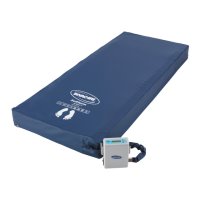
